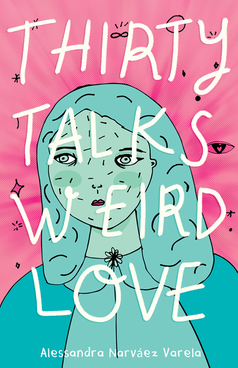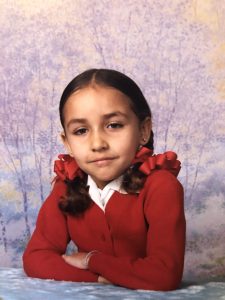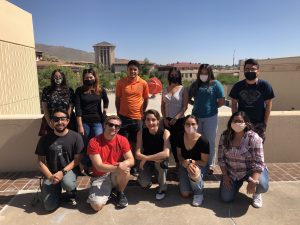In this guest post, author Alessandra Narváez Varela talks about her journey growing into her bilingualism and how that grew into her latest novel, Thirty Talks Weird Love.
 Writing about my experiences as a bilingual writer and poet was not a given for me. Not all Mexican American writers are bilingual; those who are don’t always choose to write in English and Spanish. I belong to a third group: I can write in English and Spanish and I’ve chosen to do so for my first book, Thirty Talks Weird Love.
Writing about my experiences as a bilingual writer and poet was not a given for me. Not all Mexican American writers are bilingual; those who are don’t always choose to write in English and Spanish. I belong to a third group: I can write in English and Spanish and I’ve chosen to do so for my first book, Thirty Talks Weird Love.
But the road that led me here was not straightforward.
I’ve been bilingual for a while; actually, different kinds of bilingual. I was a caterpillar bilingual as a child and teenager when I was still living in my native Ciudad Juárez. I spoke Spanish 100% of the time while learning English in school and through Reading Rainbow, Looney Toons, the Follow Muzzy videos (this is where I learned the word “clever”!), MTV and every VHS tape we rented. I didn’t get too many opportunities to use my English voice; that sleeping giant was awakened sporadically and put on the spot, accelerating my heartbeat and making me sweat by my English teachers or by CBP officers interested in the purpose of my trip to El Paso, Texas. I also sang to the tune of N’SYNC and The Beatles, misunderstanding lyrics and not caring at all.

I was an emerging bilingual, or to keep the metaphor straight, a cocoon bilingual, all throughout college. At the University of Texas at El Paso—where approximately 80% of students identify as Hispanic and where I am now a lecturer—I tended to stay in my Spanish bubble, bursting out only when I had to give presentations or go to interviews. Hearing myself speak in English was an out-of-body experience; I exited my body and heard this other Alessandra talk. Writing in English was like that too at first, for I felt myself split in too many different selves: the me who still wrote and thought in Spanish, the me who translated from Spanish to English, the me who learned direct translation (sadly before Google translate!) was not enough to write “good” English. And after all this, the me who was exhausted, mad, and, in retrospect, still irrefutably in love with the process.
Things started to change when I took my first poetry course with Dr. Rosa Alcalá. I was a moth bilingual then, and Dr. Alcalá was why: she was the first professor I was able to hear less garbled by my internal translating machine. She was also engaging, eloquent and highly intelligent; a light I wanted to blindly follow to learn all I could about poetry before going off to study medicine. I was responding to a calling I’d never taken seriously; I had “played” writer—not doctor—by writing corny poems, letters and stories from a young age. Now I was writing poetry in English. Understanding subject and technique in English. All with the help of a poet and translator who believed in me.
Yet it would take another ten years for me to invite Spanish back into my craft. Meanwhile, English said “con permiso” and pushed Spanish to the side. English to think, read and speak at medical school in Galveston, Texas. English to write to friends and relatives about my struggles with depression. English to talk to therapists. English to fall in love with my partner. English to write my application to the only bilingual MFA in Creative Writing in the U.S. Here I would meet Dr. Alcalá again, whose literary translation course tested my bilingualism, and I would also meet new mentors.

Professor Sasha Pimentel, who introduced me to Black poets like Langston Hughes whose work made proud use of the rhythms and wealth of African American Vernacular English. Dr. Andrea Cote Botero, who, in translating the work of Jericho Brown and Tracy K. Smith to Spanish, showed me the meaning of committing to a bilingual life and practice. And in the middle of my MFA, an AWP Conference where I spoke for the first time about how my bilingual trappings led to awkwardness, creative growth and discovery. Here I met the journalist who explored my experiences and those of several classmates in a New York Times article titled “Seeking a Voice, Via a Bilingual M.F.A., In Writing and In Life.”
All that seeking led me to Anamaria, the protagonist of Thirty Talks Weird Love, one restless night in January 2019, when I got out of bed and started writing. Her voice came to me clear and bilingual, mixing Spanish with English as she speaks to her bilingual friends in her also-bilingual world. Her voice came from working as a high-school tutor in Anthony, Texas where my students spoke with each other in Spanglish. With me? They spoke and wrote in Spanish or English.
This purist view limited us, especially on the U.S.-México border where you are often “ni de aquí, ni de allá.” This view influences some Mexican American writers to never go “pocho,” a term sometimes applied to Mexican Americans who mix Spanish and English supposedly because they don’t know how to use either properly, when in fact Spanglish is a legitimate hybrid English.
But who wants to use it when the literary canon is what it is—still overwhelmingly white, and not always welcoming of different Englishes? ¡Zafo! Not me!

Until I said, “Sí, why not me?” I became a monarch bilingual, bold and daring. I became a pocho rebel, a full-on, que-rollo-whatchu’-want bilingual poet—even though it’s taken me a while to get here. And before me: Tino Villanueva, Américo Paredes, Gloria Anzaldúa, Pat Mora, Sandra Cisneros, Juan Felipe Herrera, Benjamin Alire Sáenz, among others. And after me, the students whose bilingual voices enrich my classrooms, exhibiting courage and pride in their bilingualism, whether by inclination or by invitation. That’s the key. And as educators we hold it, golden and heavy, but within our grasp, so our bilingual students—be they speakers of Spanish-English, Chinese-English, Tagalog-English or of another bilingualism—reach that place of “why not?” faster.
The key, if you’re wondering about it, is multi-toothed. It can be your voice, when you embrace your accent not as broken, but as complex and absolutamente bello, and share your story with your students. When you invite active explorations of multilingualism in assignment prompts. It can also be literature by BIPOC writers on reading lists from kindergarten through high school, college and beyond, so students hear their bilingual voices clearly and see them honored between two covers. In a name and face that sounds and looks like their own. It can be the body of a writer and poet you’ve invited to talk to your students about the bilingual road they’ve lagged, walked, and skipped through or even bloodied their knees to travel.
My status now is that of a caterpillar-coccoon-moth-monarch bilingual in one. Why? I believe in language’s living status, as I continue re-learning English and Spanish while they make room for the neologisms brought on by younger generations and art forms. The growing pains of language never end. But I enjoy living in these two languages where awkwardness—my brain still translates, switches to Spanish to talk to my partner after a long day, asks for movie subtitles because my English ears prefer 3D interaction, confuses “in” and “on”— and unparalleled delight live. Delight? Yes, really.
Just imagine what it’s like to see a thing or feel a feeling and know them by two names.
About Thirty Talks Weird Love:
Thirty Talks Weird Love is a moving YA novel in verse set in 1999 Ciudad Juarez, Mexico—a time of fear when girls and women are disappearing daily. 13-year-old Anamaria is visited by a woman who claims to be her 30-year-old future self. This sudden appearance leads Anamaria to wonder: Who is this strange lady? Why does she keep saying to “just love you”? Why does she talk weird love? This thought-provoking, moving verse novel will lead adult and young adult readers alike to vital discussions on important topics—like dealing with depression and how to recognize this in yourself and others—through the accessible voice of a thirteen-year-old girl.
 Alessandra Narváez Varela was born and raised in Ciudad Juárez, México. She earned a B.S. in Biology and a Bilingual M.F.A. in Creative Writing from the University of Texas at El Paso, where she now teaches. Thirty Talks Weird Love is her debut novel. She lives in El Paso, Texas. Visit her website at alessandranarvaezvarela.com.
Alessandra Narváez Varela was born and raised in Ciudad Juárez, México. She earned a B.S. in Biology and a Bilingual M.F.A. in Creative Writing from the University of Texas at El Paso, where she now teaches. Thirty Talks Weird Love is her debut novel. She lives in El Paso, Texas. Visit her website at alessandranarvaezvarela.com.

